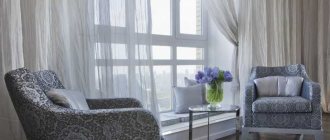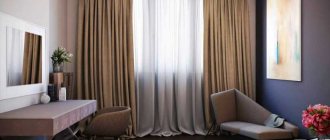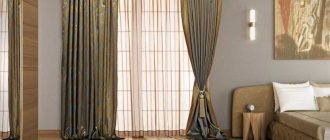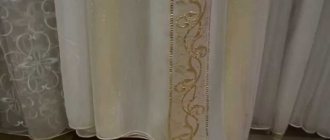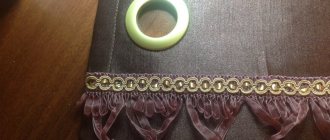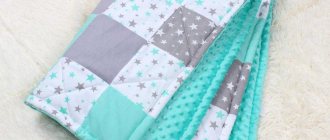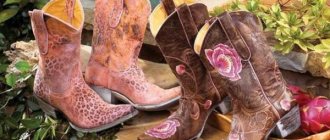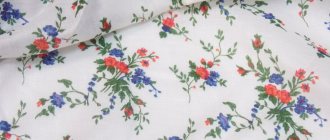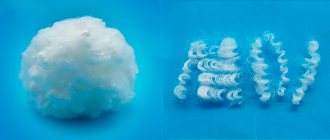Choice
The choice of curtains must be approached responsibly. At first glance, it seems that the tulles are all similar, and it doesn’t really matter which one to choose. Photos of tulle in the interior, which can be seen on the Internet, do not convey all the features of the fabric and pattern.
In fact, all tulles are made of different quality, from different materials; their choice largely depends on the interior of the room and the taste preferences of the buyer.
Please pay attention to some nuances:
- For dark and colorful curtains, it is better to choose light tulle without patterns;
- A window with an adjacent balcony door can be decorated with asymmetrical tulle;
- Bright tulle will be an appropriate accent in a room where there are many elements of brown, gray or beige.
An interior without tulle looks empty and flat. Don't neglect this element of room decoration.
How much tulle do you need?
The amount of curtain fabric purchased depends on the length of the curtain rod and the density of the material. Thin material is taken 2.5-3 times larger than the size of the cornice. Thick tulle is purchased at a rate of 1.5-2 times more.
Fashion trends do not dictate what the length of the curtain should be. Sometimes the tulle on the windows reaches the window sill, sometimes it lies in soft folds on the floor. It depends on the purpose of the room, its parameters, and interior. For the kitchen, designers advise choosing shortened options. This curtain is practical and does not weigh down the space. You can hang tulle of any length in the living room, children's room, or bedroom.
Materials
Most often, tulle is sewn from light, thin fabrics that allow air and color to pass through. It can be organza, mesh, muslin or veil.
Organza is a durable material that is made by twisting several threads. This canvas is not afraid of dust. Organza can be made from silk or synthetic fabrics.
Veil is a universal material that is soft and tender. It is less transparent. The veil is made from silk, cotton, polyester or wool.
Kisey is a light cotton fabric. It is transparent, has a perforated structure, consists of individual threads, and is a mesh. This fabric has to be washed more often, as dust particles accumulate in it, but it can be washed in a washing machine. The fabric allows sunlight and fresh air to pass through.
Types of fabric and texture
What kind of tulle is there and what is made from it? This material is used to sew embroidered curtain and trim tulle, embroidered individual items, wedding and festive clothes. Tulle is supplied to fabric stores in rolls for the convenience of forming the fabric to the desired length.
Tulle mesh
Artificial and natural fibers are used for production. Often two threads run simultaneously, which increases service life. The vertical warp and horizontal weft threads are knotted or twisted together, leaving a large open area.
The network in this case can be either small and barely visible, or large knitted. When linen is used for production, the fabric looks rough.
Cheap lace curtain tulle is used for sewing curtains for windows, as well as for finishing linen and women's dresses.
Tulle mesh
Organza
The processing technique determines the appearance of the material; it can be matte or shiny. Contains 100% polyester. To make this type of fabric, the finest fibers are selected. The use of transparent, faceted threads allows the material to shine. The composition may also include silk and viscose.
Organza is available in one color, with rainbow tints or lace. The pattern is made by embroidery, perforation or printing. The thinnest and airiest material is endowed with great strength: it does not wrinkle and holds its shape perfectly. Upon contact, the fabric is pleasant, smooth and slightly cool.
Organza
Veil
Thin cotton fabric of plain weave made from cotton, wool, silk. Made using plain weave technology. The veil is denser than organza, its threads shimmer in the light, transmit the sun's rays, but have low hygroscopicity. Today, translucent types of tulle are used for sewing wedding dresses and are used everywhere as a household decorative element.
You might be interested in what kind of fabric is used for sewing decorative sofa pillows
Veil
Weaving types
According to the type of weaving, they are distinguished:
Note!
- Curtains for windows - TOP 120 photo and video examples. Styles and shapes of curtains, their differences. Advantages and disadvantages of window curtains
- DIY curtains - instructions for sewing curtains with your own hands. Types of fabrics, colors and patterns for curtains. 120 photos + video reviews
Photos of curtains: design of curtains of different sizes and lengths. Color range, types of materials, patterns and curtain fastenings (photo + video)
Batiste is a soft and smooth fabric. It consists of thin fibers that are tightly twisted. Patterns are often embroidered on it.
Jacquard is a durable fabric with a relief created by weaving threads of different thicknesses. Chiffon does not deform and is not difficult to care for. This type of weaving looks advantageous on windows that face north. It is better to combine it with plain curtains.
Chiffon is a textured fabric that is usually decorated with additional elements - bows, ribbons or flowers.
What types of tulles are there?
Tulle is a general term. Tulle is a translucent and transparent, delicate, light, flowing fabric. This term refers to smooth, mesh or woven patterned fabrics, here are some of their varieties:
- lace is an openwork textile with an interweaving of natural or synthetic threads in the form of an elegant pattern, the elements of which are interconnected, without a fabric base, the openwork elements rhythmically alternate with a dense pattern;
- guipure (French lace) - openwork airy fabric with a lace pattern on a mesh;
- organza - elastic transparent or translucent fabric made of synthetic fibers, with shine and shimmer;
- crystallon - a type of organza, thin, light, translucent fabric, durable, elastic;
- veil - translucent delicate fabric made of the finest silk or cotton threads;
- chiffon (nylon) - thin transparent fabric made of natural or artificial silk;
- crepe chiffon - matte, airy, translucent, but denser fabric made from natural or mixed raw materials, rough to the touch but slippery;
- mesh, or tulle - a transparent fabric of cellular weave made of natural or synthetic threads, with cells of different sizes and shapes;
- gossamer - an airy thin transparent fabric made of synthetic fibers of various weaves;
- linen tulle - fabric made from thin linen threads or mixed fibers;
We also recommend: Fashionable curtains for the kitchen in 2021
- cambric is a soft, light, translucent fabric made of very thin cotton or linen, or mixed fibers;
- header - fabric made of natural, synthetic or mixed fibers, the surface is crinkled and cannot be smoothed out;
- “Rain” tulle is a type of light, airy fabric in which thickened threads are woven into a thin base, creating the illusion of thin streams of rain.
There are many more varieties of each of the above types of tulle fabrics. In addition, they can be produced with additional decorative elements: embroidery, hemstitching, lurex, sequins, rhinestones, photo printing, etc.
In addition, tulle textiles are produced with a smooth or textured surface. Smooth tulle fabric consists only of uniform thin threads. Textured tulle is a variety of lace, patterned, and mesh fabrics.
Colors
White tulle in the interior never loses its popularity. This is due to the fact that the translucent fabric is white:
- It seems light and airy. There is a feeling that the room is “breathing” and becomes fresher. This tulle makes the room visually wider;
- Combines with fabrics of any colors, with designs and patterns, with any style;
- Does not delay light, but only slightly diffuses it, making the lighting softer;
- Universal in many ways.
In the 21st century, white tulle is not the only option. Modern designers have found a lot of interesting variations in window design using tulle of different colors.
Pastel-colored tulle is combined with bright curtains; bright tulle can become an independent decorative element that creates an accent on the window.
Note!
- Organza tulle: advantages and disadvantages of the material. Varieties of tulle and fastenings. Tips for sewing and installation (photo + video)
- Tulle design - TOP 130 photos + video reviews of tulle designs. Features of choosing fabric, length, quantity and type of tulle
Gray tulle: nuances of using gray tulle in the interior. Suitable gray fabric materials. 150 photos + video examples
Cream, beige or sand tulle can easily fit into almost any interior. For those who like to bring the most daring ideas to life, tulle is made in golden and silver colors.
A children's room allows you to decorate the interior with peach, lavender, lemon or light green tulle.
Yellow tulle creates a win-win combination with blue and green curtains.
Colorful and plain curtains
Plain curtains are chosen by people who want to achieve laconicism and tranquility in the interior. Tulle of the same color cannot spoil the interior, unless it is chosen completely without taking into account the color scheme of the room.
Multi-colored curtains look more original, but you need to choose them more carefully. The interior should be thoughtful and harmonious.
Note!
Tulle on a ribbon: advantages and disadvantages of tulle on a ribbon. Types of curtain tapes. Tips for sewing and installation (photo + video)Small curtains: TOP-180 photos + video of design options for small curtains. Features of small curtains in the interior. Types of curtains, fabrics and colors
- Curtains for the hall: requirements for choosing curtains for the hall. Selecting the length, material and shade of fabric for curtains in the living room (photo + video)
Striped tulle in the interior looks appropriate if white vertical stripes are combined with pastel stripes of the same color. Sometimes bright, crazy solutions actually add color and style to the interior.
Patterns and designs on tulle should be repeated on other items. Then the room will resemble a fairy tale kingdom in which everything fits perfectly. Such a perfectionist's paradise can be created if you repeat the same pattern on decorative elements - on boxes and boxes, on a shelf, on a tablecloth or on a sofa.
The combination of several curtains in pastel shades looks very beautiful and elegant.
Colors and designs
Patterned curtain fabric is obtained in several ways:
- On multi-shuttle machines of three threads: the warp (located along the fabric), pattern-forming (tying) and forming the background and design. Jacquard devices are used to lay pattern-forming threads. Fabrics produced on a multi-shuttle machine have an open structure and can be made with various weaves.
- On shuttleless machines from two designs of threads: main and pattern-forming. The main thread, using special hook needles, forms loop columns, and the pattern-forming thread unites them with each other. The canvas is strong, but inferior to other types in terms of clarity, relief and complexity of the pattern.
- On looms, Rachel has reed needles in three threads: warp, weft and pattern-forming. The weft threads are laid across the width of the fabric through three loops of the chain, thereby forming square or rectangular cells. To form the pattern, a pattern-forming thread is introduced, which is placed in the warp loops parallel to the weft loops. Drawings obtained on openwork canvas usually consist of ordinary geometric shapes. When using jacquard systems, the pattern of the canvas is clearer and more complex, it can be geometric, abstract, plot, with fringe along the edge.
You might be interested in Features of embroidered French tulle mesh and types of fabrics used
How designs and colors are applied to tulle
Room size
The more ruffles, lace, embroidery and other details that give volume to the tulle, the more spacious the room in which it will be placed should be. In small rooms it is better to hang light, plain fabrics.
Above the windows located on the south side, you can hang tulle with a large pattern. A dark color will provide better protection from direct sunlight.
On the north side, white or light tulle made of transparent fabric will look ideal.
Curtains and drapes
How to hang tulle? The correct answer is no longer limited to one option. A fashionable interior is created in the following ways:
- Traditional - tulle is located closer to the window, curtains on the sides.
- Solo - only a transparent curtain is hung on the window, decorated with draperies, folds, coattails, and swags. When decorating, lambrequins, tiebacks, and hairpins are used.
- Modern - tulle is hung on top of heavy curtains. This combination muffles the sound of the curtains, and the curtains are saturated with their shade.
Curtains for the living room
Tulle in the living room interior can be an accent or background. A plain, lightweight, pastel-colored fabric will decorate any living room, regardless of the style of the room.
The combination of bright curtains and delicate tulle creates comfort and harmony in the room. If you want to make the room more peaceful and relaxing, you need to choose tulle and curtains of the same color, but of different saturations.
How to choose the color of curtains
Night curtains are made from curtain fabric. When decorating a bedroom window with thick curtains, not only the preferred color is important, but also its shade. In order not to visually burden the interior, they prefer textiles of blurred shades
Gray curtains
It is known that any color has many transitional shades. For curtain decor, designers recommend:
- smoky;
- graphite;
- gray-blue;
- pearl gray;
- “dusty rose” (gray-pink).
All these variations will nobly set off white, light lilac or pale blue tulle.
Curtains for the bedroom
In the bedroom, plain and delicate tulle creates an atmosphere of peace and comfort. The use of bright tulle is not allowed. It will irritate the eye and interfere with proper rest.
Tulle with guipure inserts is a combination of modern design and classics.
When choosing curtains for the bedroom, try to combine the colors of the tulle, curtains and bedspreads.
